Toyota Carina II test by the English magazine Autocar. 1988! — Toyota Carina II, 1.6 liter, 1988
Karina II is one of those models that was not covered in the press in Russian during the assembly line life. At least I have not seen such publications. This is understandable, it was produced from 1988 to 1992. During this period, officially, and unofficially, it was not sold with the USSR, and, accordingly, there were no test drives. I personally really missed this, I think many Russian-speaking owners too. Therefore, when I saw scans of such a test, and even such an authoritative English magazine, I almost immediately decided to translate it and post it here.
So, the test of "Karina" by English journalists in 1988 in Russian, especially for DRIVE2.RU users!
Thank you for your help in translating antonnot
Autocar magazine. April 27, 1988.
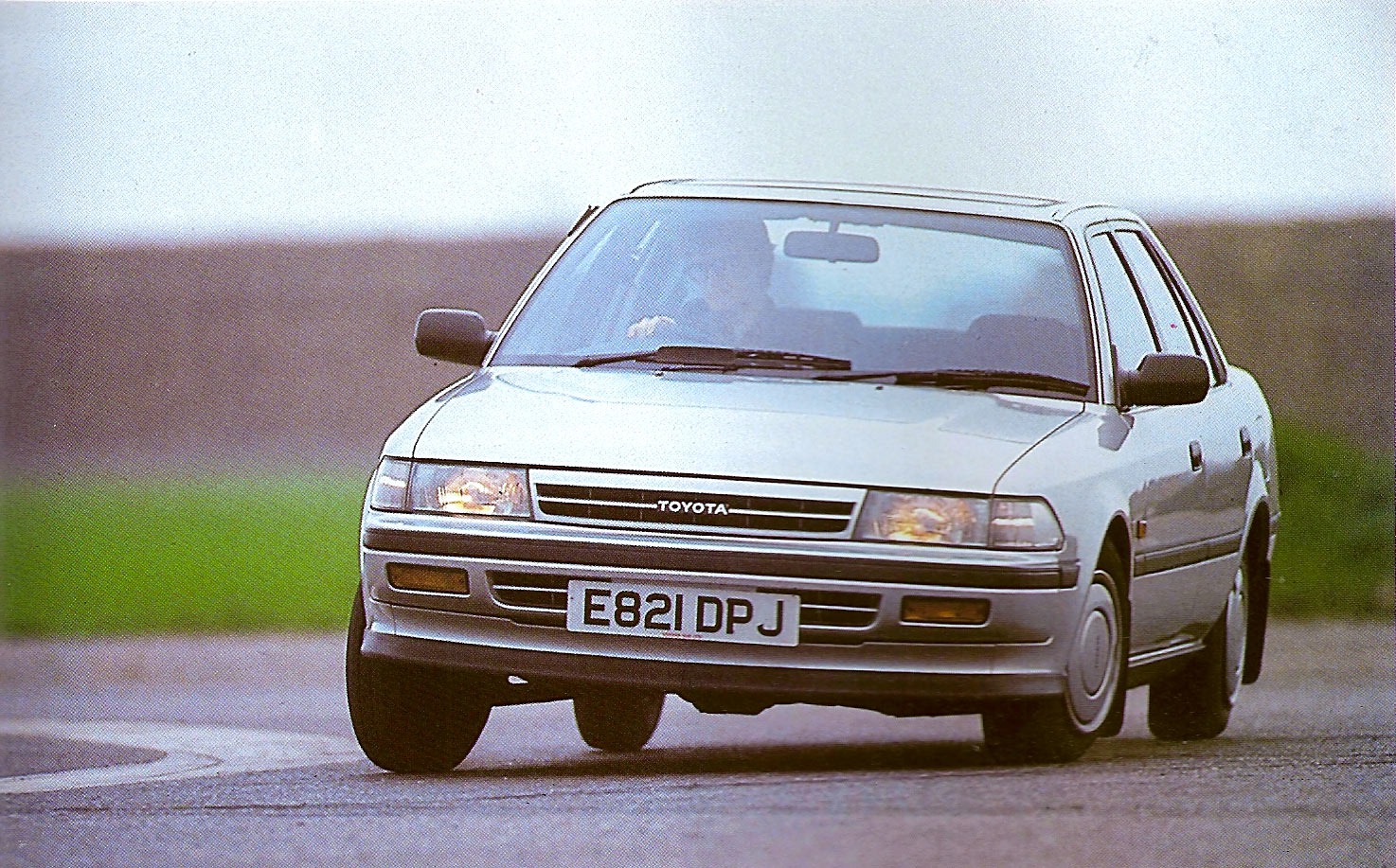
The forgotten member of the Toyota family received a little pepper, a sleek appearance, a 16-valve engine and a suspension with European settings. She has flaws, but this is a machine with which it is very easy to get along.
Price £9830 Top speed 170 km/h Acceleration from 0 to 100 km 10.8 s Fuel consumption 8.25 l/100 km Pros Appearance Cons Handling Price
At first glance, it is rather difficult to see where the new Karina fits in the British market. In the close and comprehensive Toyota lineup, Karina falls between the Corolla, whose competitor is the Escort, and the Camry, which is logical to compare with the Sierra and Cavalier.
On the one hand, this should be disadvantageous in terms of sales for people whose thinking does not go beyond the “four classes†stereotype, and on the other hand, a big plus for those who want a car larger than the Escort, but do not want the Sierra or "Cavalier". (Apparently at that time the British did not have a clear class D and "Karina" was one of the first in it. Translator's note).
Due to the limitation in the number of imported models, Toyota has decided to limit the number of Carina trim levels supplied to the UK, concentrating on the most profitable, closer to the upper limit of the market niche.
This is also why the available engines are closer to the Sierra than to the Escort. (Didn't know the Sierra was an E class. Translator's note). The Karina is sold here with either a 1.6-litre or 2.0-litre engine, and the 2.0-litre engine is only available in a lavishly equipped liftback. Despite this lack of choice, prices still gravitate towards the upper bar - which is slightly offset by the traditionally rich standard Japanese equipment.
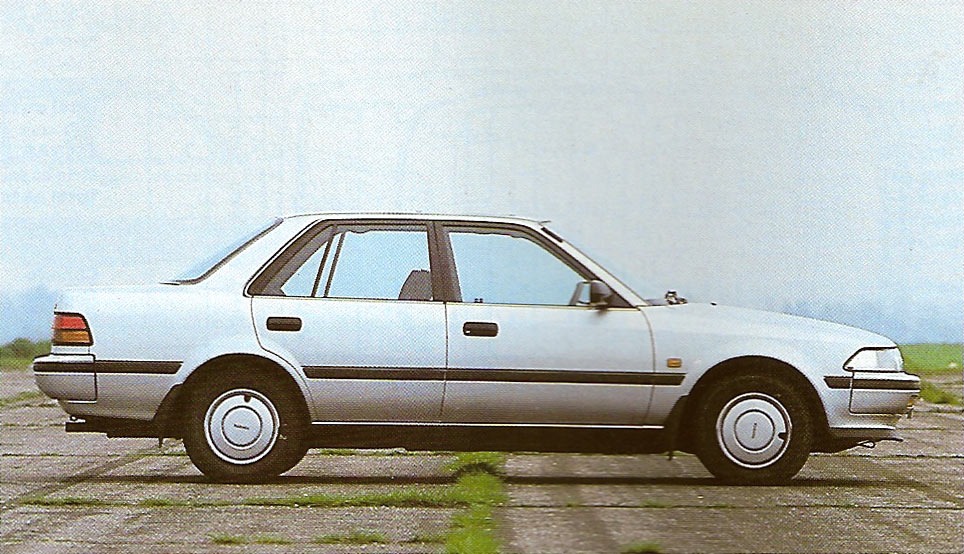
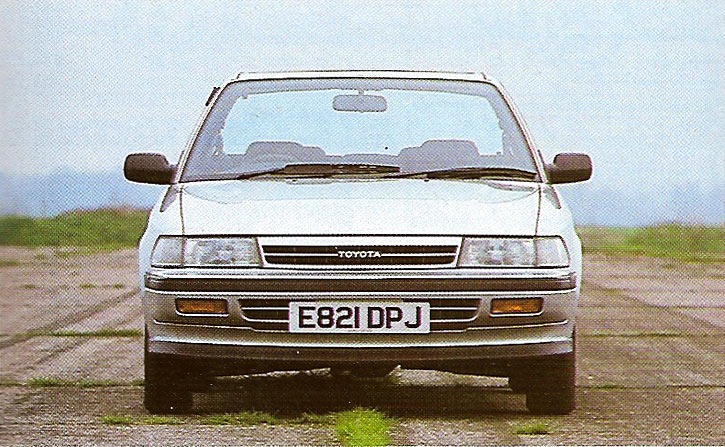
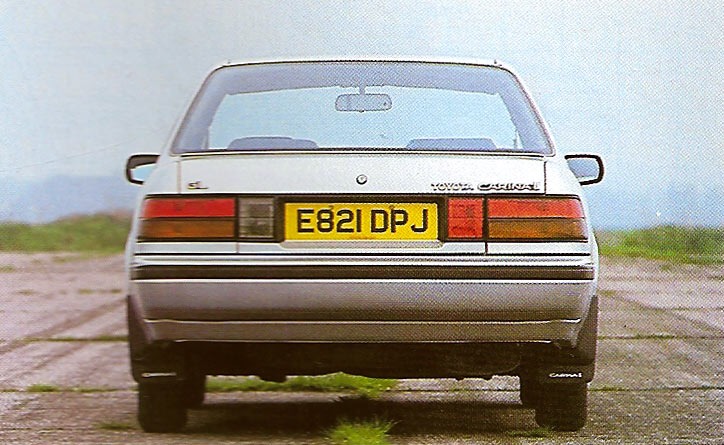
PERFORMANCE
"Karina" 1.6 GL is equipped with the same engine as the most powerful "Corolla". This is a 4-cylinder, 16-valve engine with a carburetor. With an average noise level, it develops 94 hp. at 6000 rpm and 100 lb ft of torque at 3600 rpm. Mechanically quiet, with a smooth ride, with a cold start it works smoothly even from idle. Elasticity is good and continues all the way to the beginning of the red zone at 6300 rpm.
Toyota claims a top speed of 180 km/h and acceleration from 0 to 100 km in 11 seconds. We were only able to accelerate to 170 km / h, but were able to improve acceleration to hundreds to 10.5 seconds. This is quite justified, looking at the structurally quite heavy Karina with an excellent aerodynamic coefficient Cx 0.33. The maximum speed in fifth gear corresponds to 5170 rpm.
When accelerating, the data shows a flat engine torque curve. The time to cover every 30 kilometers in acceleration from 15 to 110 in fourth gear is almost the same and the best acceleration time of 6.8 seconds from 80 to 110 kilometers in third gear in the class. That's a good comparison to the Peugeot 405 1.6 GL, which does it in 7.5 seconds.
On the road it behaves like a typical small sedan. "Karina" is not a lazy person, but she is not a fireball either. Power builds up smoothly and steadily with improvements in the mid-torque zone. There is no high-rpm pickup here, just a gradual increase in power throughout the range.
The front wheels are driven by a 5-speed manual transmission or an optional 4-speed automatic. The gearbox has a double cable drive, gear changes are quick and easy.

ECONOMY
Despite being heavier and more powerful than most rivals, the Karina's fuel consumption is quite competitive. The overall figure of 8.4L/100km was the result of an intense test session at the Millbrook test track, where the figure soared to 11.7L/100km in a quiet ride. This is in line with the easily revving engine and the driver's desire to make the most of the excellent shifting gearbox.
Under much less unusual circumstances, consumption crossed the 7.8L/100km mark, with a fairly relaxed ride we achieved a better figure of 7.35L/100km, accounting for a 1.5 percent odometer error.
"Karina" will run on any of the simple grades of gasoline, 97 improved, leaded or cheaper 95 unleaded, with no obvious differences in consumption and behavior.

ROAD BEHAVIOR
The Karina's chassis and suspension have been designed by Toyota with the tastes of European drivers in mind. Under light load, the chassis is rigid, MacPherson struts carefully dampen impacts, steering play and compensate for unwanted tire side slip in all drive wheel positions.
In some respects, Japanese engineers have succeeded. Smoothness is very good, springs and dampers swallow small imperfections in the road with ease. Even with reflectors and concrete, the suspension copes easily, although there is some buildup and roll on big waves.
It is difficult to make a mistake in driving the Karina at medium speeds, a slight understeer builds up gradually increasing with increasing steering angle.
Driving aggressively, chassis flaws pop up. The combination of soft springs, minimal lateral stiffness, narrow gauge, high profile Dunlop SP7s 165SR13 tires with limited dry grip result in severe side-to-side sway and severe understeer when cornering at speed.
Corner entry is fuzzy, as soon as the weight is transferred to the outside front wheel, the tires begin to squeak and sag. Obviously, braking will only make things worse, although when you let off the gas, the car is screwed into the corner with a slight tendency to skid the rear axle.
These features allow inexperienced drivers to enter corners at speed quite safely, but fuzzy responses and a lack of side grip only frustrate the active driver. But the situation is even worse when driving at high speed on a really bumpy road. In such circumstances, the shock absorbers do not do their job and the ride quality drops dramatically.

EQUIPMENT
Here, the assessment of the new "Karina" is high. Quiet, responsive engine, comfortable ride, pleasant controls and overall low noise levels make long-distance travel a breeze in the Karina. Power mirrors, a four-speaker radio and power steering are standard, but there are no central locking or power lifts.
At speed, noise levels are very low and tire performance is almost invisible on most surfaces. The engine and exhaust system are well insulated and the transmission runs smoothly. The seats are comfortable, with three-position adjustable lumbar support, as well as an adjustable backrest and driver's seat cushion. Although the rear seats are not as hospitable.
Based on the equipment, Karina fits well into the class standards and only a soft suspension that gives a comfortable ride, sacrificing handling, deserves significant criticism. Although it is quite adequate at moderate speeds.
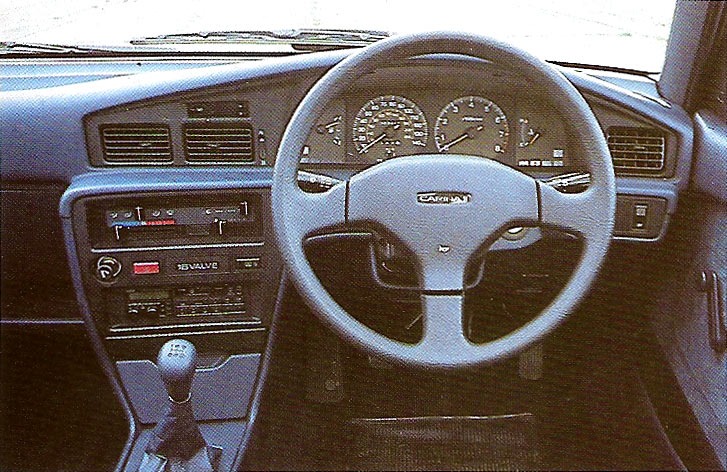
BEHIND THE DRIVE
"Karina" of cars of this type, in which any driver, sitting behind the wheel, feels at home. Everything works easily and clearly. With seat and handlebar adjustment, most riders will find a comfortable riding position. The headroom is enough even for people taller than 183 centimeters - but there may not be enough legroom for them.
The predominantly dark blue interior of the test car was finished to a high standard with quality materials. In general, the interior gives the impression of a monotonous, but well thought out. The seats and door panels are finished in velour, which pairs well with the seat belts and plastic panels. The gray center console slightly dilutes the gloomy range, but the 16 valve inscription looks out of place in such a conservative interior.
All controls are well positioned and easy to reach, including all switches, the order of which is well thought out. Familiar paddle shifters for wipers/washers and light controls are located on either side of the three-spoke steering wheel. Visibility is good, large rear-view mirrors help, and bright headlights allow you to maintain a safe speed at night.
However, the heating and ventilation system could be improved. Temperature adjustment sliders, air distribution, fan and recirculation mode are good and there are air ducts in all the usual places. But there is no way to send warm air to the legs, and cold air to the face.
CONVENIENCE
For people of average build, the seats of the Karina are quite comfortable, while for large people they are not spacious enough.

Worst of all, for rear passengers, with the front seats pushed back as far as possible, there is barely enough space for the knees, while there is still distance above the head. The rear seat is equipped with a center armrest. Both front seats have headrests, which unfortunately do not have height adjustment (On my "Karina" there is height adjustment, but not tilt adjustment. Translator's note).
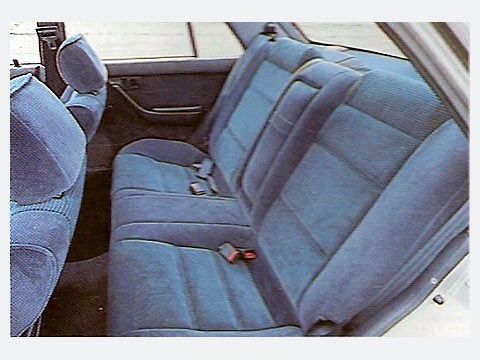
If passenger capacity is just what you expect, then luggage space far exceeds it. Under the trunk lid hides an impressive space for luggage, and if this is not enough, then you can fold the separate rear seat backs. There is even a niche for a full-size spare wheel, located below the floor level.

The cabin has full-length door pockets, a lockable glove box with a small shelf underneath, a box with a lid under the radio in the front panel, a small niche in the center console and map pockets behind each seat.
Thoughtful little things, such as the illumination of the ignition switch when opening the driver's door and the buzzer when the lights are left unswitched.
There are also two interior dome lights, power mirrors, and a glass sunroof with power tilt and slide.
VERDICT
In almost every way, the Toyota Carina 1.6 GL meets or exceeds our expectations from a Japanese manufacturer. The build quality and finish is first class, the ride is quiet, improved and comfortable. The design is attractive, the performance is good, and reliability should be up to standard Toyota standards.
On the flip side, the Carina isn't as roomy as the Ford Sapphire 1.6 or Vauxhall Cavalier, and it costs more. Steering and straight-line stability are challenged by compromised suspension and narrow tires, so sophisticated drivers will look for alternatives in models with more sparkle.
However, for most drivers, the Karina is presented as an attractive, comfortable and practical four-door sedan.
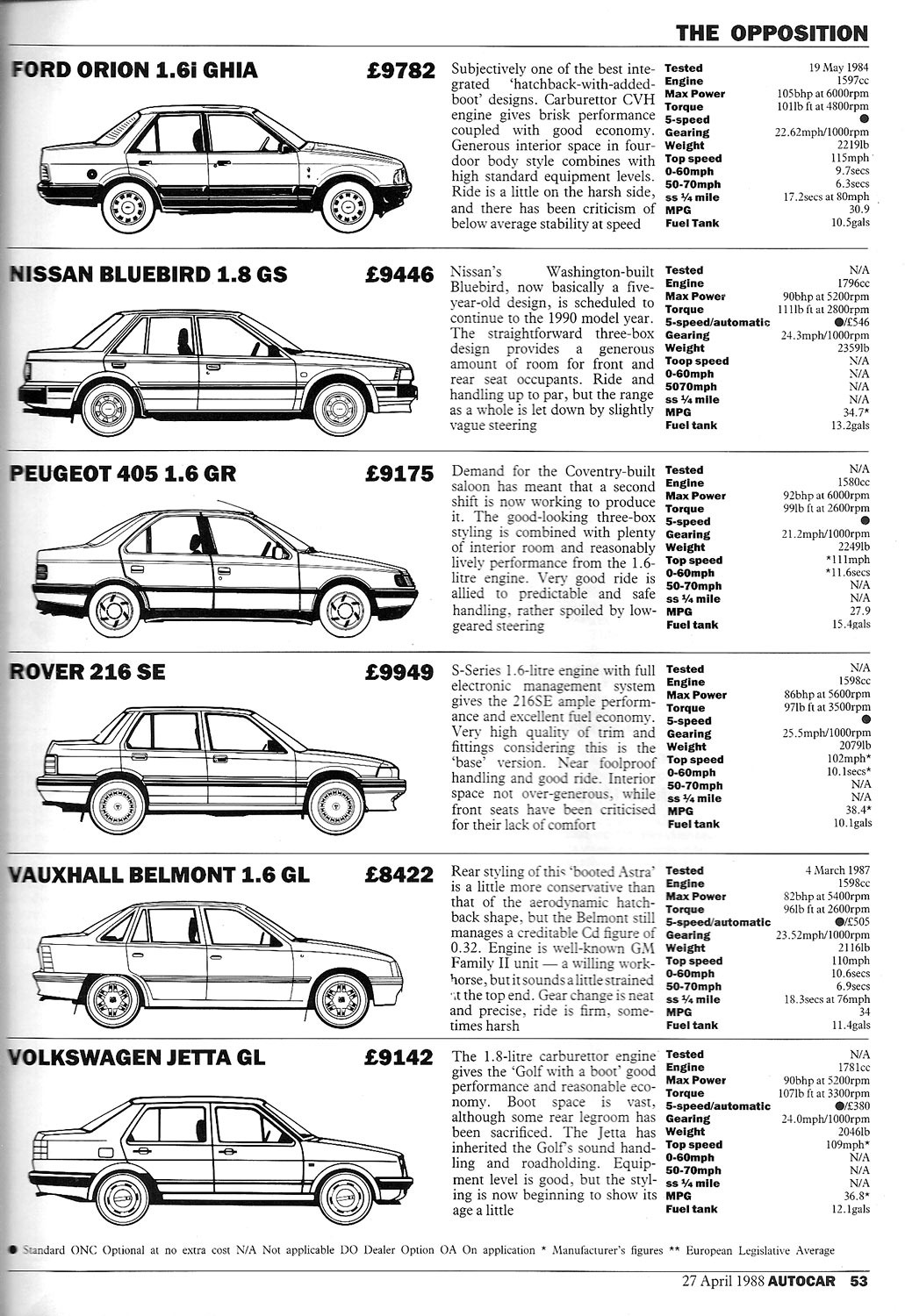
 Spare parts on the photo: 1151827 , 4060124
Spare parts on the photo: 1151827 , 4060124Original article
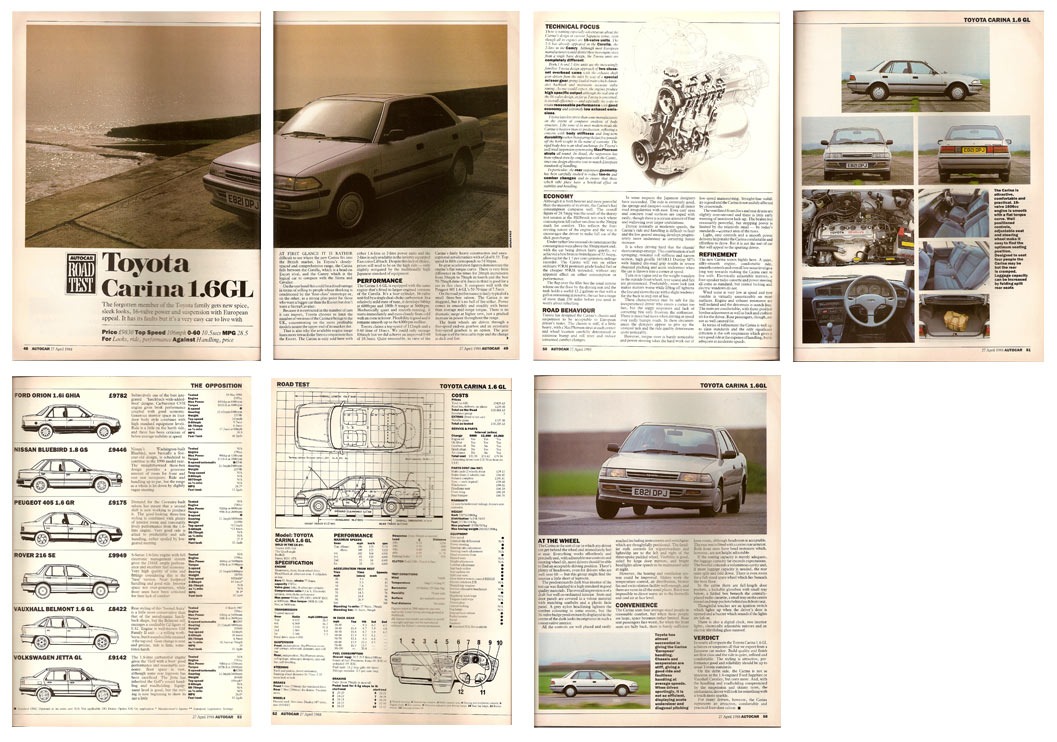
Thanks to the author of By Trigger's Retro Road Tests! on Flicker for scans of this article: www.flickr.com/photos/triggerscarstuff/
Original article in English: www.flickr.com/photos/tri...98926333/with/3390442980/
Spare parts HOSE 1151827 Ford SP.LED PANEL 4060124 FordRom42
An entertaining article, but I don’t understand why the author is looking for some kind of “sparkle†in the handling of Karina ... Well, I probably don’t agree with the author’s comments about the “monotonousness†of the interior (of all the competitors presented, only the Peugeot salon can be distinguished). And the rest, it seems, everything is correct! Thanks Vitally for the info!
+1, liked it!
I do not agree that he is angular, he is the most rounded of all (Owned the cadet for 2 years)
It may be in general form, but in detail it is angular. The Koreans tried to fix their Daewoo and it turned out Nexia
anton not
And it seemed to me that there was nothing to even compare with Peugeot, everyone was so outdated compared to Karina's streamlined body.
by the way, cadet is more optimistic
Bluebird is good but a little dated. By the way, in that period it is very clearly seen how more streamlined forms became fashionable.
Rom42
An entertaining article, but I don’t understand why the author is looking for some kind of “sparkle†in the handling of Karina ... Well, I probably don’t agree with the author’s comments about the “monotonousness†of the interior (of all the competitors presented, only the Peugeot salon can be distinguished). And the rest, it seems, everything is correct! Thanks Vitally for the info!
And it seemed to me that there was nothing to even compare with Peugeot, everyone was so outdated compared to Karina's streamlined body.
You are welcome! He is looking for a spark and does not find it, apparently so that future buyers know what they are taking. This is why such an article is valuable, which compares direct competitors during the period of sale on the market, that is, without any discounts for age or anything else. And the credibility of the publication allows you to hope for objectivity. For example, from the presented competitors, I only drove a Peugeot as a passenger. And I really liked it! He definitely has a spark, and the interior is interesting. In this sense, I agree with the journalist.
An entertaining article, but I don’t understand why the author is looking for some kind of “sparkle†in the handling of Karina ... Well, I probably don’t agree with the author’s comments about the “monotonousness†of the interior (of all the competitors presented, only the Peugeot salon can be distinguished). And the rest, it seems, everything is correct! Thanks Vitally for the info!
I also noticed that the approach is different. Apparently the high culture of society and the great experience of such tests are affecting. You won't get him anywhere. After all, they probably have them for probably soon a hundred years.
Great post!
Indeed, at that time there were no original tests in Russian and could not be, and no one subjected their babies to such tests as they are on the track. The more interesting it is to read this test. In our family, for example, it was the first foreign car, and everyone tried to groom and cherish it.
The test is written in a completely different style than our journalists. A lot of attention is paid to the behavior on the road, the description of the materials, and there is a sense of uncompromising, they speak directly and do not evade. I liked it very much.
Digree
Respect for the article! More real fans like this. It was very interesting to read the opinion of Autocar. It is a pity that nothing is written about the two-liter. I know this resource for a long time, but my English is weak. I would like to read everything that is scanned there :)
You are welcome! To be honest, halfway through I decided to quit this business, because I don’t know English well either. Sometimes, if the author’s thought is very intricate and I can’t translate one sentence a day. And about the car, I think they somehow took a two-liter car for a test, it's just not on the flicker. By the way, you can ask the author, he can lay out.
It would be cool, but I must say it's a hell of a job to translate the English, and even in such a specific topic, so many incomprehensible words, just a teaspoon per hour.
Respect for the article! More real fans like this. It was very interesting to read the opinion of Autocar. It is a pity that nothing is written about the two-liter. I know this resource for a long time, but my English is weak. I would like to read everything that is scanned there :)
As you know, in test drives such an indicator as reliability is not taken into account. And in this discipline, Toyota has few competitors.
I think that now, after a lapse of time, Toyota has coped with its competitors, in any case, much more of them survived, in Odessa, that's for sure. As the saying goes, "spring showed who and where shit." And THANK YOU for the article, well, goodies!
This is probably unlikely, but there are probably still very good specimens in Europe. They know how to handle cars.
An interesting article, thanks,
You can masturbate on the engine compartment photo =) buzz. Everything is so clean and new!
Super! ! ! well done kudos to you! ! ! By the way, it's cool in the article Cadette is called Belmont
specifics of different markets. For a more accurate comparison, you need to compare Karina 2 with the Crown. These are the same cars, but the configurations are still completely different.
the configurations are completely different ( ( (in Japanese, it seems that in the standard there is a conder, window lifters, etc.
AK-471
But the situation is even worse when driving at high speed on a really bumpy road. In such circumstances, the shock absorbers do not do their job and the ride quality drops dramatically.
Remembering my Karina, I fully confirm this idea. The shock absorbers really didn't handle the bumpy road and often made their way. And replacing with new ones did not give anything.
I wonder where they dug up bumpy roads there? This is their professionalism, they specially dug out potholes and tested them to check - what if it breaks!
But the situation is even worse when driving at high speed on a really bumpy road. In such circumstances, the shock absorbers do not do their job and the ride quality drops dramatically.
Remembering my Karina, I fully confirm this idea. The shock absorbers really didn't handle the bumpy road and often made their way. And replacing with new ones did not give anything.
Vitally
I think it used to be S.
That is:
Hunchbacked Cossack - And
Eared Cossack - To
Kopeyka - From
Volga -? E probably.
It turns out that there was no D class in the USSR.
was D-class. Moskvich 2141 ) ) )
Well, then the USSR) then everyone was not competitors to each other, but accomplices. like all together for the good of the country. where the government said to transfer production there and transferred. from that it turned out that what one plant developed, another plant produced.
Exactly! He hits D, everything converges. It was just in the USSR - one class - one model!
I think it used to be S.
That is:
Hunchbacked Cossack - And
Eared Cossack - To
Kopeyka - From
Volga -? E probably.
It turns out that there was no D class in the USSR.
anton not
Only I would classify the VAZ 2109 as B class.
Escort - Focus now (C class), and Cadet - Astra became, also C class.
Golf 2 - Nine is just in one class C. Now the class has grown and the nine is already B + (according to the autoreview classification)
automaniac
why all of a sudden? Lada 2109 in those days was no less than Golf and Astra)
Probably yes, before the nine it was C.
automaniac
why all of a sudden? Lada 2109 in those days was no less than Golf and Astra)
brothers, I wouldn’t stick a vaz here, it’s all about cars, but here it’s just a car without options and without everything, the engine and body of classification do not lend themselves at all
automaniac
because the Jetta (that is, Golf2) is like a VAZ 2109, well, of course, in terms of quality, but in terms of comfort they are very close. Or rather, interior decoration. and the 405 is head and shoulders above them both. there and tidy modern and everything else. besides, the 405th and Karina were originally like the D class - the "family" was on (now the D-class is huge like the Volga). and Jetta: With "Compact" Golf class. just a rival of Cadet and Escort.
Only I would classify the VAZ 2109 as B class.
Escort - Focus now (C class), and Cadet - Astra became, also C class.
No, the Granada is a bit big, it's most likely an E-class. Now I thought, maybe the European classification appeared later and we are arguing in vain here.
IGRIK133
Yes, the trade winds of those years are just at the level of Karina! then the cadet doesn’t fit, the Vectra fits into this series, well, I can’t say anything about Ford, I don’t like them
Ford Granada seems to be asking me here) it seems he was the predecessor of the Mondeo)
Vitally
And what year was the Vectra, maybe it wasn't there then?
what happened before her? Askona chtol? was either a Vectra or a dash) because the Cadet then turned into an Astra, and Astra, as we know, became a competitor to the Corolla.
correctly, the cadet was replaced by an aster, even the letters from the cadet moved to the aster, the last cadet is E, and the first aster is F
Yes, from 88 en.wikipedia.org/wiki/Ope...A_.281988.E2.80.931995.29 and by the way, she came to replace Ascona, not Cadet. Well, apparently it came a little later, the test date is April 1988.
from 1988 to 95 Vectra A was produced, although I could be wrong about Astra F and Cadette E, I know everything!
Yes, the trade winds of those years are just at the level of Karina! then the cadet doesn’t fit, the Vectra fits into this series, well, I can’t say anything about Ford, I don’t like them
automaniac
because the Jetta (that is, Golf2) is like a VAZ 2109, well, of course, in terms of quality, but in terms of comfort they are very close. Or rather, interior decoration. and the 405 is head and shoulders above them both. there and tidy modern and everything else. besides, the 405th and Karina were originally like the D class - the "family" was on (now the D-class is huge like the Volga). and Jetta: With "Compact" Golf class. just a rival of Cadet and Escort.
I agree. It was necessary to compare with the Passat. The Jetta is a C-class.
It should be borne in mind that the Camry is a model primarily for the United States, and there are completely different classes. If we take the European classification, then the Camry-A6 of course. But for Europe it is too big and simple.
In general, there are times when the dimensions do not have to be taken into account. for example Toyota Camry with whom to compare it with the Audi A4 or Audi A6? or the same Passat B5. in terms of dimensions like the Audi A6, and in terms of equipment level it is not cooler than the Volvo S40) but in this case the comparison with the Jetta was overkill) )
IGRIK133
good knowledge! But I dare to object, because in those years, on the Cadets, LSD panels were installed instead of the instrument panel and the recaro interior 16-valve engines, etc., etc., it will be better than a fawn)))
But the classes differ mainly in size. Everything else later. Otherwise, there would be confusion.
automaniac
I feel I came across Opelevoda) ) ) ) ) )
I have nothing bad against Opel) I like Astra myself) but Cadet and Peugeot405 they are like different generations of cars ... by the way, we don’t forget about Vectra A. she was just the same as the main competitor like Karina, and Peugeot 405. and Example P10) ) ) ) )
+1
yes, brother, I drove Opels until grease, until now Astra F in the back of a Caravan is standing next to the grease)))
I feel I came across Opelevoda) ) ) ) ) )
I have nothing bad against Opel) I like Astra myself) but Cadet and Peugeot405 they are like different generations of cars ... by the way, we don’t forget about Vectra A. she was just the same as the main competitor like Karina, and Peugeot 405. and Example P10) ) ) ) )
good knowledge! But I dare to object, because in those years, on the Cadets, LSD panels were installed instead of the instrument panel and the recaro interior 16-valve engines, etc., etc., it will be better than a fawn)))
because the Jetta (that is, Golf2) is like a VAZ 2109, well, of course, in terms of quality, but in terms of comfort they are very close. Or rather, interior decoration. and the 405 is head and shoulders above them both. there and tidy modern and everything else. besides, the 405th and Karina were originally like the D class - the "family" was on (now the D-class is huge like the Volga). and Jetta: With "Compact" Golf class. just a rival of Cadet and Escort.
the British themselves seem to be confused in the classification of cars) how did their Peugeot 405 turn out to be a classmate of the Cadet and the Jetta? ) ) ) and it's not just the size)
You are confusing something, Karina is in any case higher than the Corolla in the classification. I understand everything about the Japanese. But I still confuse the Koreans. They have several models in one class, and if not a fan, it is very difficult to figure it out.
automaniac
I think you're right) because not all manufacturers considered it necessary to produce "niche" cars) hence the incomprehensible class of Karina, Trade Winds appeared) ) ) ) )
friends, I don’t understand the classification at all, I’m talking about the Japanese, the carina of those years is higher than the Corolla, but lower than the Camry, the carina which for Europe is lower than the Corolla, it turns out that the manufacturers themselves confused the car classes, I think the Germans suffered the same misfortune
but less than the first SUVs. before they could calmly knead the muddy dirt road or rush along the beaches, but now they can’t even do that ... well. with rare exceptions)
so the SUV was originally with a stripped-down transmission and a light chassis. but the clearance allowed climbing through curbs and snowdrifts. and now they are so low that four-wheel drive is already useless in this regard. you will sit in a snowdrift on your belly)
A four-door coupe is actually the same hatchback or sedan. And the name is marketing, advertising, it just doesn't sound so mundane.
And about SUVs, they are crossovers for that, which combine both a passenger car and an SUV, so that it is convenient in the city and you can drive through easy off-road terrain.
Well, I have some kind of stereotype left. For example, I don’t understand how a coupe can be a four-door or a five-door?! (mercedes cls, audi a7).
and I don’t understand the current fashion to make all-wheel drive squat. you might think that our curbs have become lower once the SUVs have become low) ) ) ) )
One way or another, everything lends itself to classification, it just may not be the one we have in mind. At the beginning of the article there is a text: stereotype of four classes. That's where all the fuss comes from. We don’t have such a concept, and even now it’s already apparently the same.
I think you're right) because not all manufacturers considered it necessary to produce "niche" cars) hence the incomprehensible class of Karina, Trade Winds appeared) ) ) ) )
Well, yes. cast iron and steel are stronger than aluminum and plastic)
it’s just that in old cars a lot doesn’t break there because it doesn’t exist)
automaniac
than something with you solgasen. for me, the perfect compromise between modernity and conservatism were cars of the late 90s. There are too many electronics now. yes, of course, the safety that they give is significant, but they also deprive the car of vitality.
it's not about electronics, it's just that after 2000, all cars began to be made brittle! look for yourself more than one car with a motor designed for a million no maximum resource 350-400 thousand It was in the nineties that all the developments ended, the filling only changes but nothing new was invented ((((
I like both modern and old. And then and now there are a lot of beautiful cars. Everything is developing smoothly.
than something with you solgasen. for me, the perfect compromise between modernity and conservatism were cars of the late 90s. There are too many electronics now. yes, of course, the safety that they give is significant, but they also deprive the car of vitality.
I think all the comments can be summed up in one line! ! ! And to say that the cars of the late 80s and early 90s are truly legendary, you can talk about all cars for a long time, look for the pros and cons. A common feature of those old cars, RELIABILITY! while proven over the years and millions of runs!
I was happy when I drove a Cadette I was happy when I drove an Astra, I’m happy to drive a Karina, but I’m not happy when I get into fresh cars (( (I don’t know why, all my cars are my age or almost the same, probably that’s why they attract me so much!
Opel or Toyota it doesn’t matter Nissan or Foltz, it doesn’t matter, they are all good, they are all for the SOUL
Thank you. It was for the owners of Karin that we got confused with the translation
good article! and I, as a driver with no great experience, was even interested =) catch bagels for the article!
You are welcome! It is always interesting what people of a completely different civilization think about the same thing.
You are welcome! My truth is less than 10 did not come out. But here we have a mountainous terrain and traffic jams.
Thank you very much!) It was interesting to read. Converge a lot!) I
also noticed in my own way, even if driving in an aggressive mode around the city, the consumption is somewhere around 8.2-8.4l / 100km.
Was Karina 2 produced for Japan? There they are called Crowns. About her, I have an entry in the BZ www.drive2.ru/cars/toyota…rnal/4062246863888416761/
And by the way, judging by the profile on the site, you don't have a car :)
I drive a Karina 2 in the back of an AT 170. Pure Japanese (right-handed), in fact, an analogue of a European, there are only slight differences in the design of the body and interior.
No, it's Toyota Carina in the back of AT 170. SD Extra package. I have a car, I just didn't take a picture. I'll take a photo tomorrow and post it. And the crown is an analogue of Karina E, please do not confuse.
Perhaps in mechanics, and the body panels and interior differ decently. But this seems to be the same case as with these Japanese pairs: ED-Exiv or Celica-Curren.
Sorry Karina. I just didn't express myself that well. I meant that the Japanese and European Carinas (in the bodies of AT 170 and AT 171) are 90 percent interchangeable in terms of details.
And on the body panels, too (the front and rear of the sedan are almost completely, except for the hood, trunk lid, headlights, turn signals and tail lights. Differences in the connection of turn signals, the shape of the headlights is different, and the rear lights). You can also install an exhaust system from a European if you remove your own (the docking mounts are different). Therefore, if you put a rear can from a European, then you also need to change the intermediate pipe.